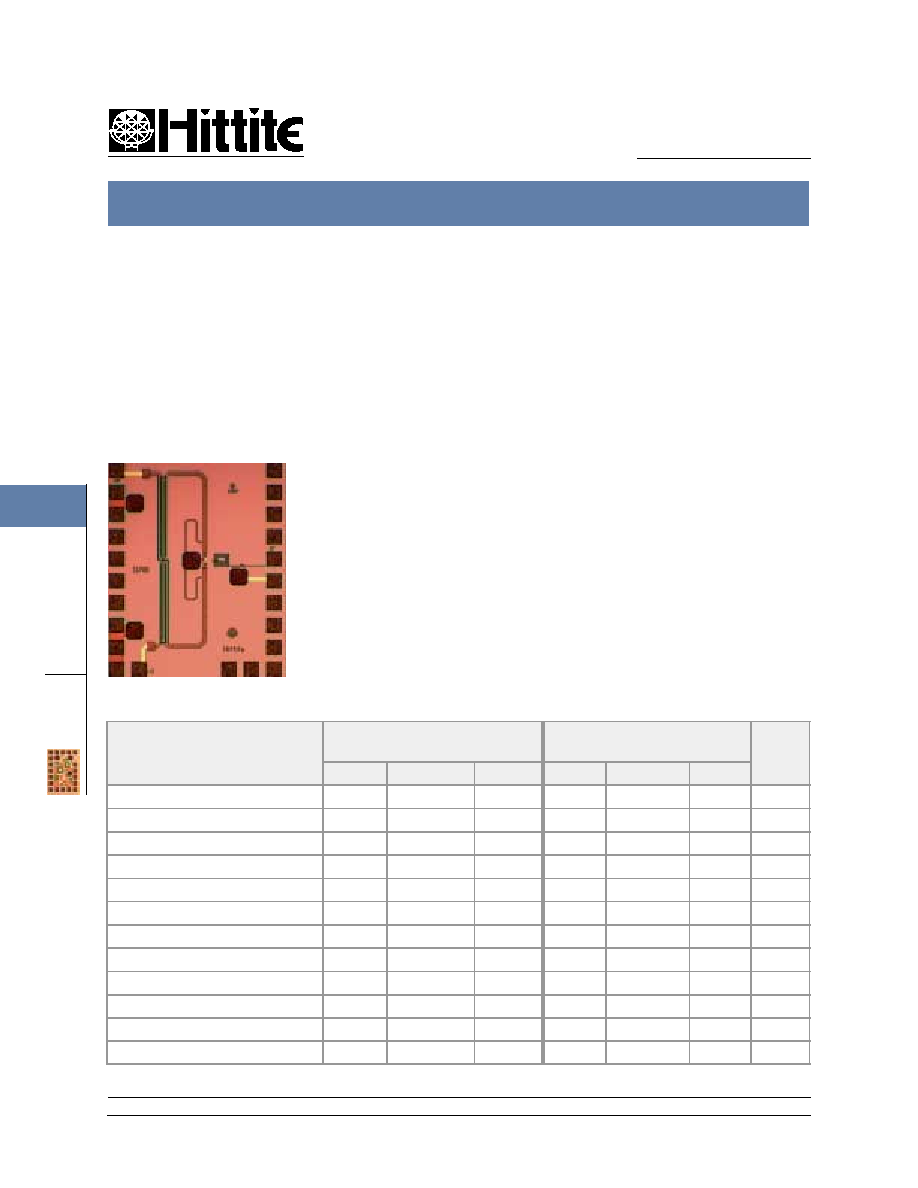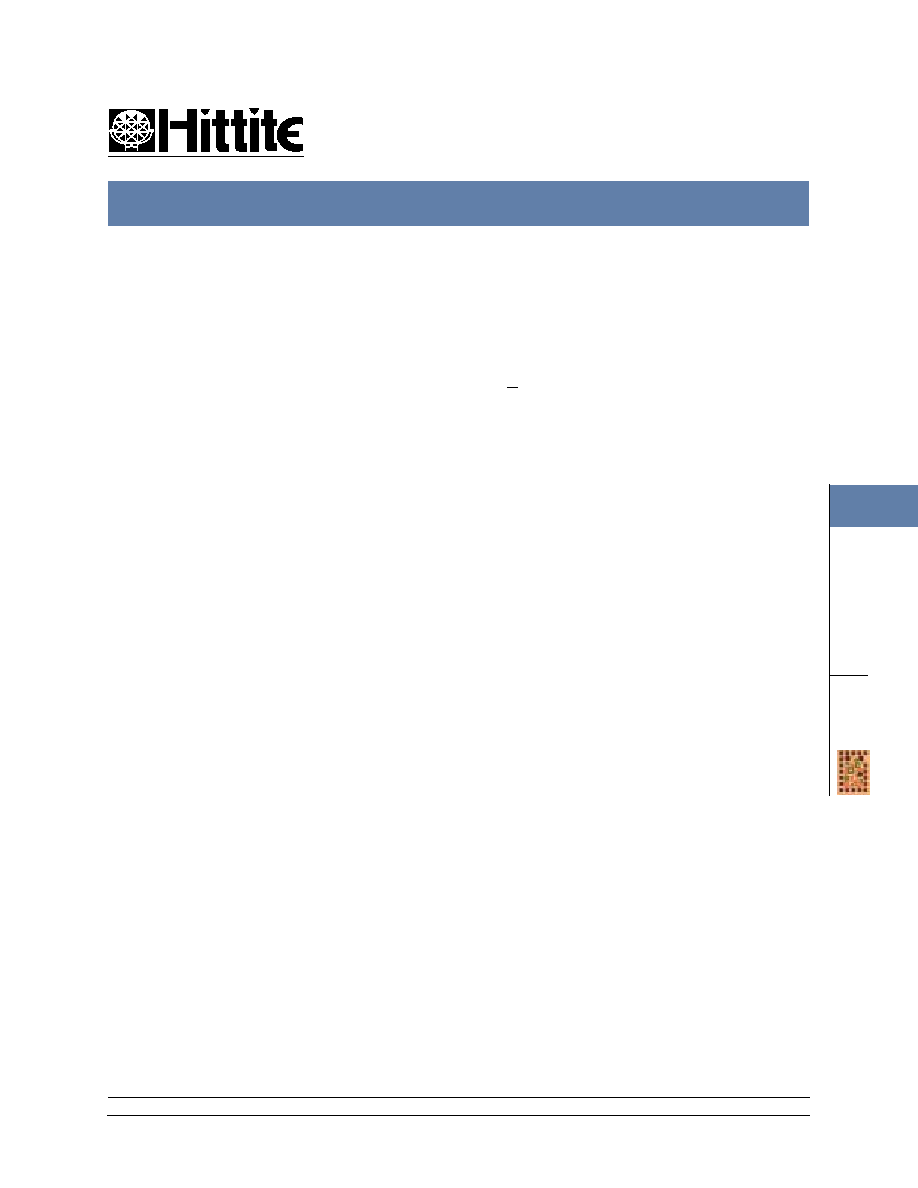 | –≠–ª–µ–∫—Ç—Ä–æ–Ω–Ω—ã–π –∫–æ–º–ø–æ–Ω–µ–Ω—Ç: HMC259 | –°–∫–∞—á–∞—Ç—å:  PDF PDF  ZIP ZIP |

4 - 112
12 Elizabeth Drive, Chelmsford, MA 01824 Phone: 978-250-3343 Fax: 978-250-3373
Web Site: www.hittite.com
M I C R O W A V E C O R P O R A T I O N
F
EBRUARY
2001
y2k
new!
M
IXERS
4
DIE
Features
SUB-HARMONICALLY PUMPED (x2) LO
HIGH 2LO/RF ISOLATION: > 35dB
SMALL SIZE: 1.24mm x 1.55mm
IDEAL FOR 38 GHz RADIOS, E1 & T1
Parameter
IF = 1 GHz
IF = 1 GHz
Units
Min.
Typ.
Max.
Min.
Typ.
Max.
Frequency Range, RF
28 - 40
36 - 40
GHz
Frequency Range LO
14 - 20
18 - 20
GHz
Frequency Range, IF
DC - 12
DC - 4
GHz
Conversion Loss
14
17
12
15
dB
Noise Figure (SSB)
14
17
12
15
dB
2 LO to RF Isolation
28
35
40
50
dB
2 LO to IF Isolation
58
65
63
68
dB
RF to IF Isolation
25
30
25
32
dB
LO to IF Isolation
10
15
12
17
dB
IP3 (Input)
2
5
2
6
dBm
1 dB Compression (Input)
-7
-4
-7
-1
dBm
Local Oscillator Drive Level
+13
+15
+18
+13
+15
+18
dBm
General Description
The HMC259 chip is a broadband sub-harmoni-
cally pumped (x2) balanced MMIC passive mixer
which can be used as an upconverter or
downconverter. The chip utilizes a GaAs MESFET
process resulting in a small overall chip area of
1.9mm
2
. This chip has a very wide IF bandwidth
of DC-13 GHz. The 2LO to RF isolation is
excellent eliminating the need for additional fil-
tering . This mixer chip is designed to be used in
38GHz point to point radios, Local Multi-Point
Distribution Systems (LMDS), and SATCOM ap-
plications. All data is with the chip in a 50 ohm test
fixture connected via 0.025 mm (1 mil) diameter
wire bonds of minimal length <0.31 mm (<12
mils). This device is a much smaller and more
reliable replacement to hybrid diode mixer de-
signs.
GaAs MMIC SUB-HARMONICALLY PUMPED MIXER 28 - 40 GHz
Guaranteed Performance*,
LO Drive=+15dBm, - 55 to + 85 deg C
HMC259
* Configured as a downconverter

4 - 113
12 Elizabeth Drive, Chelmsford, MA 01824 Phone: 978-250-3343 Fax: 978-250-3373
Web Site: www.hittite.com
M I C R O W A V E C O R P O R A T I O N
F
EBRUARY
2001
y2k
new!
4
M
IXERS
DIE
-30
-25
-20
-15
-10
-5
0
24
26
28
30
32
34
36
38
40
CONVERSI
ON
GAI
N
(
d
B)
RF FREQUENCY (GHz)
+13 dBm
+16 dBm
+15 dBm
+14 dBm
Return Loss @ LO = +15 dBm
-40
-35
-30
-25
-20
-15
-10
-5
0
0
5
10
15
20
25
30
35
40
RETURN
L
O
SS
(
d
B)
FREQUENCY (GHz)
LO & RF
IF
-25
-20
-15
-10
-5
0
24
26
28
30
32
34
36
38
40
CONVERSI
ON
GAI
N
(
d
B)
RF FREQUENCY (GHz)
+85 C
-55 C
+25 C
-80
-60
-40
-20
0
24
26
28
30
32
34
36
38
40
IS
OL
A
T
ION
(
d
B
)
RF FREQUENCY (GHz)
RF/IF
LO/IF
RF/LO
2LO/RF
2LO/IF
-30
-25
-20
-15
-10
-5
0
0
1
2
3
4
5
6
7
8
9
10 11 12 13 14 15
I
F
CONVERSI
ON
GAI
N
(
d
B)
IF FREQUENCY (GHz)
Conversion Gain vs. Temperature
@ LO = +15 dBm
IF Bandwidth @ LO =+15dBm
Isolation @ LO = +15 dBm
HMC259 SUB-HARMONICALLY PUMPED MIXER 28 - 40 GHz
Conversion Gain vs. LO Drive
-30
-25
-20
-15
-10
-5
0
24
26
28
30
32
34
36
38
40
CONVERSI
ON
GAI
N
(
d
B)
RF FREQUENCY (GHz)
Upconverter Performance
Conversion Gain @ LO = +15dBm
HMC259

4 - 114
12 Elizabeth Drive, Chelmsford, MA 01824 Phone: 978-250-3343 Fax: 978-250-3373
Web Site: www.hittite.com
M I C R O W A V E C O R P O R A T I O N
F
EBRUARY
2001
y2k
new!
M
IXERS
4
DIE
0
10
20
30
40
50
60
24
26
28
30
32
34
36
38
40
SECOND
O
RDER
I
NTERCEPT
(
d
Bm
)
RF FREQUENCY (GHz)
+25 C
-55 C
+85 C
0
4
8
12
16
20
24
26
28
30
32
34
36
38
40
THI
R
D
O
RDER
I
NTERCEPT
(
d
Bm)
RF FREQUENCY (GHz)
+14 dBm
+16 dBm
+15 dBm
0
10
20
30
40
50
60
24
26
28
30
32
34
36
38
40
SECOND
O
RDER
I
NTERCEPT
(
d
Bm
)
RF FREQUENCY (GHz)
+15 dBm
+16 dBm
+14 dBm
0
4
8
12
16
20
24
26
28
30
32
34
36
38
40
THI
R
D
O
RDER
I
NTERCEPT
(
d
Bm)
RF FREQUENCY (GHz)
+25 C
+85 C
-55 C
Input IP2 vs. LO Drive
Input IP3 vs. LO Drive
Input IP3 vs. Temperature
@ LO = 0 dB
m
Input IP2 vs. Temperature
@ LO = 0 dBm
HMC259 SUB-HARMONICALLY PUMPED MIXER 28 - 40 GHz
nLO
mRF
± 5
± 4
± 3
± 2
± 1
0
-3
-2
-37
-1
-46
-48
-22
0
-28
+29
1
X
-24
-29
2
-40
-44
-81
3
-76
RF = 30 GHz @ -15 dBm
LO = 14 GHz @ +15 dBm
All values in dBc below IF power level
MXN Spurious Outputs
@ LO Drive = 0 dBm
-5
-4
-3
-2
-1
0
1
2
3
4
5
24
26
28
30
32
34
36
38
40
P1dB
(
d
Bm
)
RF FREQUENCY (GHz)
+25 C
+85 C
-55 C
P1dB vs. Temperature
@ LO =+15 dBm
HMC259

4 - 115
12 Elizabeth Drive, Chelmsford, MA 01824 Phone: 978-250-3343 Fax: 978-250-3373
Web Site: www.hittite.com
M I C R O W A V E C O R P O R A T I O N
F
EBRUARY
2001
y2k
new!
4
M
IXERS
DIE
HMC259 SUB-HARMONICALLY PUMPED MIXER 28 - 40 GHz
Outline Drawing
( See Die Handling, Mounting, Bonding Note Page 4-116)
Absolute Maximum Ratings
RF / IF Input
+13 dBm
LO Drive
+23 dBm
Storage Temperature
-65 to +150 deg C
Operating Temperature
-55 to +85 deg C
Schematic
1.55
(0.061)
1.35
(0.053)
0.76
(0.030)
0.10
(0.004)
0.10
(0.004)
0.15
(0.006)
1.04
(0.041)
1.24
(0.049)
LO
H i t t i t e
IF
RF
BACKSIDE
IS GROUND
ALL DIMENSION IN MILLIMETERS (INCHES)
ALL TOLERANCES ARE ±0.025 (0.001)
DIE THICKNESS IS 0.100 (0.004) BACKSIDE IS GROUND
BOND PADS ARE 0.100 (0.004) SQUARE
BOND PAD SPACING, CTR-CTR: 0.150 (0.006)
BACKSIDE METALLIZATION : GOLD
BOND PAD METALLIZATION : GOLD
RF
IF
LO
HMC259

4 - 116
12 Elizabeth Drive, Chelmsford, MA 01824 Phone: 978-250-3343 Fax: 978-250-3373
Web Site: www.hittite.com
M I C R O W A V E C O R P O R A T I O N
F
EBRUARY
2001
y2k
new!
M
IXERS
4
DIE
HMC259 SUB-HARMONICALLY PUMPED MIXER 28 - 40 GHz
MIC Assembly Techniques for HMC259
LO
IF
RF
Mounting & Bonding Techniques for Millimeterwave GaAs
MMICs
The die should be attached directly to the ground plane eutectically
or with conductive epoxy (see HMC general Handling, Mounting,
Bonding Note).
50 Ohm Microstrip transmission lines on 0.127mm (5 mil) thick
alumina thin film substrates are recommended for bringing RF to
and from the chip (Figure 1). If 0.254mm (10 mil) thick alumina thin
film substrates must be used, the die should be raised 0.150mm (6
mils) so that the surface of the die is coplanar with the surface of the
substrate. One way to accomplish this is to attach the 0.102mm (4
mil) thick die to a 0.150mm (6 mil) thick molybdenum heat spreader
(moly-tab) which is then attached to the ground plane (Figure 2).
Microstrip substrates should brought as close to the die as
possible in order to minimize bond wire length. Typical die-to-substrate spacing is 0.076mm (3 mils).
Figure 3: Typical HMC259 Assembly
HMC259

4 - 117
12 Elizabeth Drive, Chelmsford, MA 01824 Phone: 978-250-3343 Fax: 978-250-3373
Web Site: www.hittite.com
M I C R O W A V E C O R P O R A T I O N
F
EBRUARY
2001
y2k
new!
4
M
IXERS
DIE
Ball or wedge bond with 0.025 mm (1 mil) diameter pure gold wire. Thermosonic wirebonding with a nominal
stage temperature of 150 deg. C and a ball bonding force of 40 to 50 grams or wedge bonding force of 18 to
22 grams is recommended. Use the minimum level of ultrasonic energy to achieve reliable wirebonds.
Wirebonds should be started on the chip and terminated on the package or substrate. All bonds should be
as short as possible <0.31 mm (12 mils).
Handling Precautions
Wire Bonding
The chip is back-metallized and can be die mounted with AuSn eutectic preforms or with electrically
conductive epoxy. The mounting surface should be clean and flat.
Eutectic Die Attach:
A 80/20 gold tin preform is recommended with a work surface temperature of 255 deg. C and a tool tem-
perature of 265 deg. C. When hot 90/10 nitrogen/hydrogen gas is applied, tool tip temperature should be
290 deg. C.
DO NOT expose the chip to a temperature greater than 320 deg. C for more than 20 seconds. No more
than 3 seconds of scrubbing should be required for attachment.
Epoxy Die Attach:
Apply a minimum amount of epoxy to the mounting surface so that a thin epoxy fillet is observed around
the perimeter of the chip once it is placed into position.
Cure epoxy per the manufacturer's schedule.
Mounting
Follow these precautions to avoid permanent damage.
Cleanliness: Handle the chips in a clean environment. DO NOT attempt to clean the chip using liquid
cleaning systems.
Static Sensitivity: Follow ESD precautions to protect against > ± 250V ESD strikes ( see page 8 - 2 ).
Transients: Suppress instrument and bias supply transients while bias is applied. Use shielded signal and
bias cables to minimize inductive pick-up.
General Handling: Handle the chip along the edges with a vacuum collet or with a sharp pair of bent twee-
zers. The surface of the chip has fragile air bridges and should not be touched with vacuum collet, twee-
zers, or fingers.
HMC259 SUB-HARMONICALLY PUMPED MIXER 28 - 40 GHz
HMC259





